Putty for leveling and creating a smooth surface of walls before decorative finishing, types of material, composition of mixtures and their properties. Wall putty is a building material intended for leveling the wall surface and its finishing before final finishing, for example, gluing wallpaper or painting. The treatment of the base with putty is an integral part of the technological process for the renovation of premises. The final result largely depends on its quality characteristics.
Varieties of putty for walls by grain size
The putty is divided into two types, taking into account the grain size, which determines the purpose and order of application of the solution. So, putty can be starting, finishing, universal. The names speak for themselves, however, what are the main differences between these species. Let's describe their characteristics in more detail.
Starting wall putty
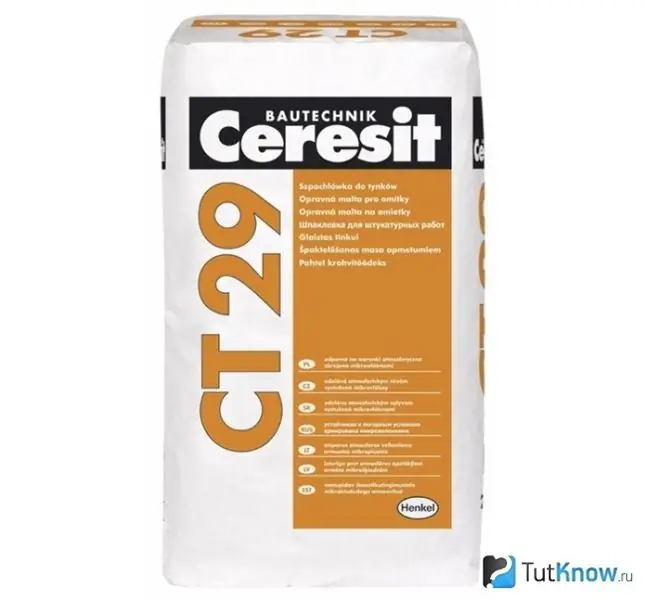
The starting wall putty serves as the basis for further wall finishing, because it has the following characteristics:
- Differs in larger grain compared to finishing solutions. Because of this, it is rather difficult to sand. The surface of the frozen starting mixture is rough. It is mainly used for starting wall decoration, leveling and filling small cracks.
- It is used in works with brick and concrete surfaces.
- Has a high drying rate.
- Does not crack over time, creating a solid base for any kind of finishing materials.
- It can be applied in a layer from 0.3 to 2 cm.
Coating with starter putty can be the penultimate step in wall renovation. However, given that such a surface will be quite rough, the final coating can be wall panels, dense heavy wallpaper, but not thin wallpaper or paint.
Let's take a look at a few specific examples of popular starter mixes:
- Scanmix TT (Finland) … Universal starter putty. Has a cement base, is applicable indoors and outdoors. This putty is waterproof, frost-resistant. With the maximum possible layer of 2 cm, complete hardening occurs in a day. The cost is low (from 280 rubles for 25 kg of dry mix). Shrinkage of the mass during drying is possible.
- Knauf HP starting (Germany) … On a plaster base. It is used for finishing interior walls where there is no high humidity. Possible layer thickness - from 4 to 15 mm. Complete hardening occurs in a day. The mass does not shrink. The coating has a high degree of strength. The cost is about 360 rubles for a package weighing 30 kg.
- Ceresit CT 29 (Germany) … Universal putty (interior, exterior). Not recommended for use in rooms with high humidity levels. During filling and drying, the ambient temperature should be in the range of + 5 … + 32 degrees. However, further operation is possible even at sub-zero temperatures (up to -50 degrees). The speed of complete hardening is high - from 10 to 15 hours. The composition contains a polymer (microfiber), which provides high strength. 25 kg of dry mix costs from 430 rubles.
Finishing putty for leveling walls
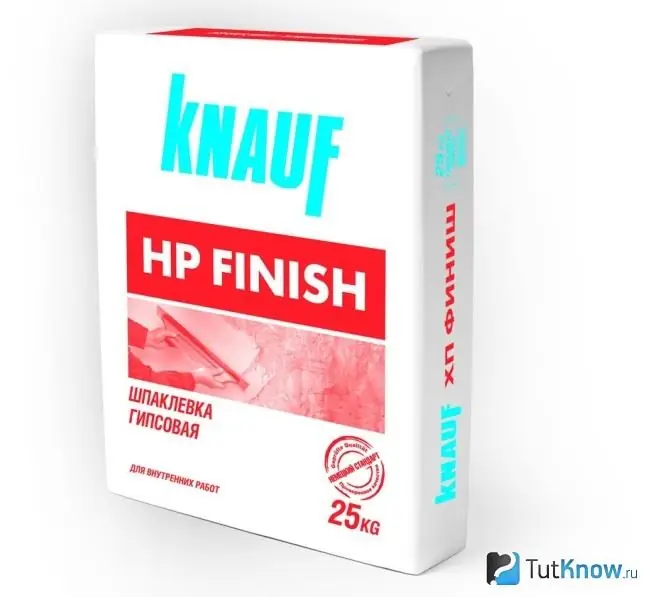
Finishing putty for walls is intended for the final stage of preparation of the base for finishing. It can be described using the following characteristics:
- Creates a smooth surface thanks to its creamy consistency.
- Applies only to a pre-leveled surface.
- It is applied in a thin layer (from 0.1 to 0.4 cm). In other cases, the solution shrinks, cracks appear. In addition, a thick layer is difficult to smooth over the surface, because the mass can float.
- It is easy to sand, and after the complete drying of the finishing mixture, a large amount of dust is formed.
- It is less durable than starter mixes.
Here are some examples of finishing mixes:
- Knauf HP finishing (Germany) … On a plaster base. Recommended only for rooms with normal humidity levels. Complete hardening takes 15-24 hours. One of the most durable putties among analogues. However, large, hard particles are often found in the mixture, which create a certain complexity in the work. The cost of a 25 kg bag is about 390 rubles.
- Ceresit CT 225 (Germany) … Has a cement base. The finish coat becomes durable, smooth, and has a white color. The main disadvantage is the high cost (790 rubles per 25 kg).
- Scanmix LH Standart (Finland) … It is based on polymers. The mass does not shrink. Universal, i.e. suitable for all types of premises. The coating is characterized by perfect whiteness, so the finish surface can be left unpainted. It is quite expensive (the average price is 900-1000 rubles per 25 kg).
Universal wall putty
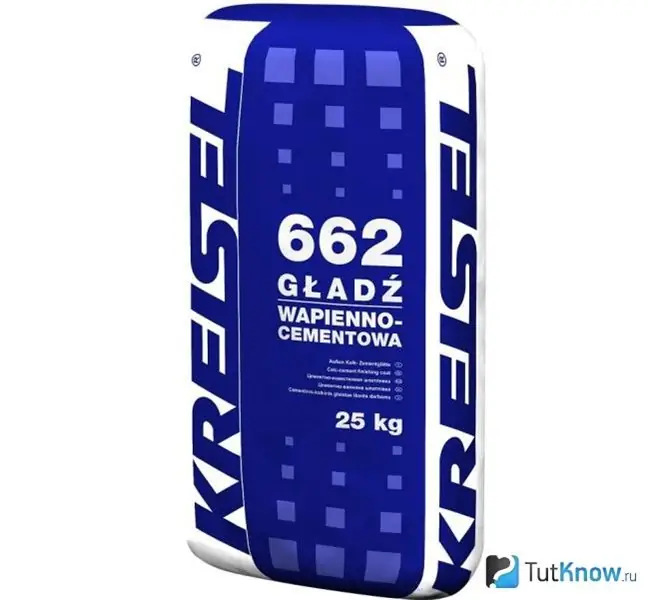
The universal formulations combine the main characteristics of the starting and finishing masses. Those. it can be used with slight irregularities in the surface of the wall, while after drying, a sufficiently smooth surface is formed. The cost of such material is slightly higher. But, despite this, the quality of the universal layer is significantly inferior to the classic technology using start and finish.
Among the many universal putties, Kreizel 662 (Germany) stands out. It is based on cement and lime. The composition is improved with additives that increase the resistance to operational loads. Suitable for rooms with any level of humidity. To prevent cracks from appearing due to shrinkage of the mass, the layer must be more than 3 mm. The cost is average (about 350 rubles per 25 kg).
Considering the above characteristics, the question of which putty is best for walls, many can answer - "universal".
Types of wall putties according to the degree of readiness for use
In stores, putty is presented in two types - dry mixes and ready-made solutions. Each type has its own advantages and disadvantages. Let's consider them in more detail.
Dry mixes for wall putty
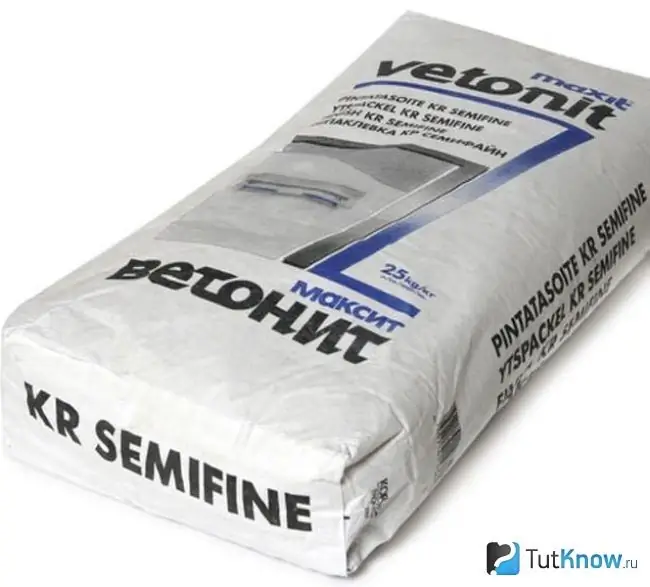
Powder mixtures for wall putty are powdery compositions that must be diluted with water before direct application to the wall, mixing thoroughly by hand or using a construction mixer to a homogeneous consistency.
The advantageous aspects of dry formulations are as follows:
- The ability to vary the density of the solution by adding different amounts of water.
- Simplicity in the preparation of the solution.
- Convenient transportation.
- Long-term storage, unpretentious in terms of temperature.
- Lower price than ready-made solutions.
Disadvantages of dry mixes:
- Small time-consuming preparation of the solution.
- After kneading, such mixtures should be used quickly enough, for each specific product the time frames are different - from 15 minutes to 1 hour.
- It is recommended to knead in small portions.
- During storage, the mixture is afraid of moisture. There is a great potential for deterioration if water gets in. packing - cardboard.
Ready mortars for walls
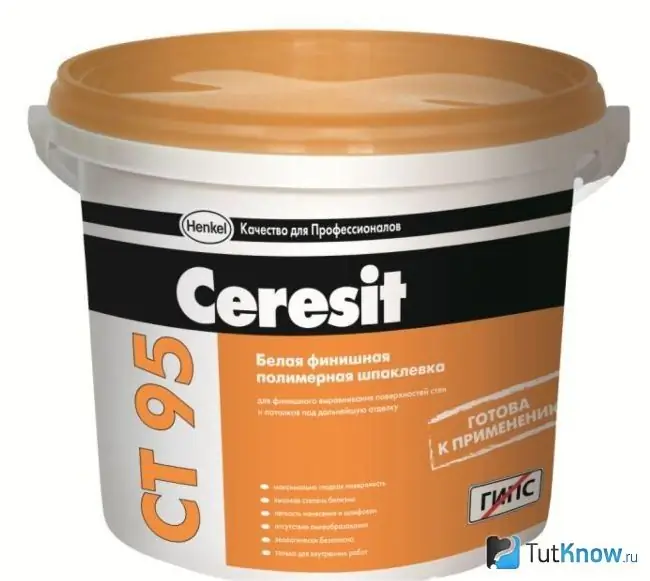
The finished wall putty is packed in plastic buckets. Latex or new generation dispersions are most often used as a base. It is stored in the form of a solution for a long time due to the fact that it contains special substances that do not allow it to solidify. You can apply the finished mass immediately after opening the package.
Advantages of ready-made mixtures:
- Higher ductility.
- No need to use additional means to prepare the solution.
- The closed ready-made solution can be stored for a long time even after the first opening.
As the main disadvantage, the cost is higher in comparison with dry mixtures.
Classification of wall putties by composition
Each manufacturer independently chooses an assortment of his goods, focusing on a particular consumer market. Due to the rapid progress in all spheres of life, there are many technologies for the production of mixtures for filling, which use different components. Ultimately, the composition directly affects the properties of the putty. Let's take a closer look at what base can be used to make putty, what properties, advantages and disadvantages are provided by different ingredients in order to highlight the types of putties for walls in composition.
Cement putty for walls
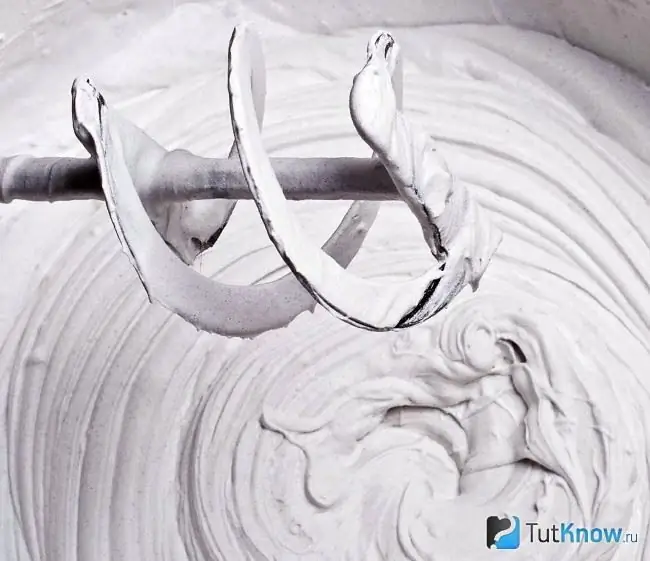
In the case of cement putty for walls, the composition includes cement, sand as a filler and a solvent. For high-quality putty, only cleaned sand is used (a prerequisite is the presence of no more than 5% of impurities such as clay). The different ratio of cement, sand and solvent determines the grade of the mortar, on which the strength depends.
The positive properties of cement putty are as follows:
- Not afraid of moisture.
- Suitable for rooms with high humidity, as well as for walls outdoors.
- Has high strength after drying (the more cement and less sand, the stronger the layer is).
Negative sides:
- It is used as a base for finishing putty or decorative plaster.
- The mass is subject to shrinkage upon drying.
- Low elasticity.
- Not suitable for wood surfaces.
- There are certain difficulties in working with concrete walls.
- Cracking is possible during operation.
- They are gray.
Gypsum wall putties
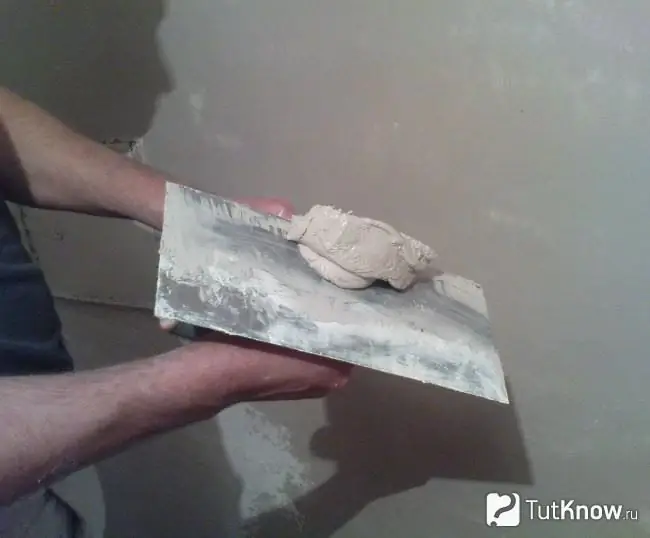
Plaster putty for walls is an excellent finishing solution.
Advantages of gypsum plaster:
- Breathable material.
- Does not shrink and crack.
- Creates perfectly smooth surfaces, therefore significantly reduces paint and glue consumption.
- Suitable for the finest finishing materials, including paint.
- High drying speed.
- There are no smells.
- Increased fire resistance.
- Low price.
- The components are non-allergenic.
- Has a white color after drying.
Among the disadvantages are the following:
- Does not withstand changes in temperature and humidity.
- The surface is not resistant to mechanical damage, chips may appear.
- Narrow purpose - only for interior decoration in dry rooms.
Polymer mixtures for filling walls
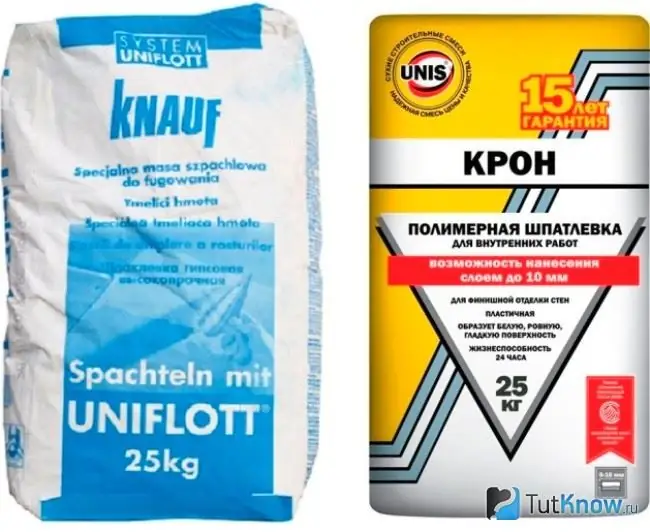
Advantages of polymer mixtures:
- High elasticity.
- Durability of a durable coating.
- Increased water resistance.
- The mass does not shrink.
- Wide range of applications.
- The prepared solution can be stored for 12 hours.
The disadvantages of polymer-based putties are as follows:
- Great value.
- Often there are low-quality fakes at a high price.
There are two types of putties with a polymer base:
- Acrylic wall putty … Universal option (interior and exterior). Possesses increased adhesion, weather resistance. Most often it is a finishing solution, because with its help, you can easily create a perfectly smooth surface. Its peculiarity is that the layer should be minimal - up to 1 mm. Suitable even for wood surfaces. It is not toxic. The mixtures have a long shelf life. A type of acrylic putty is water-dispersion.
- Latex putty … Suitable for indoor use only. Poorly tolerates low temperatures. Possesses good plasticity, strength, durability. Easy to apply. Does not emit odors. Can be applied to concrete, metal, plaster, drywall, wood surfaces.
Oil and glue putty for wall preparation
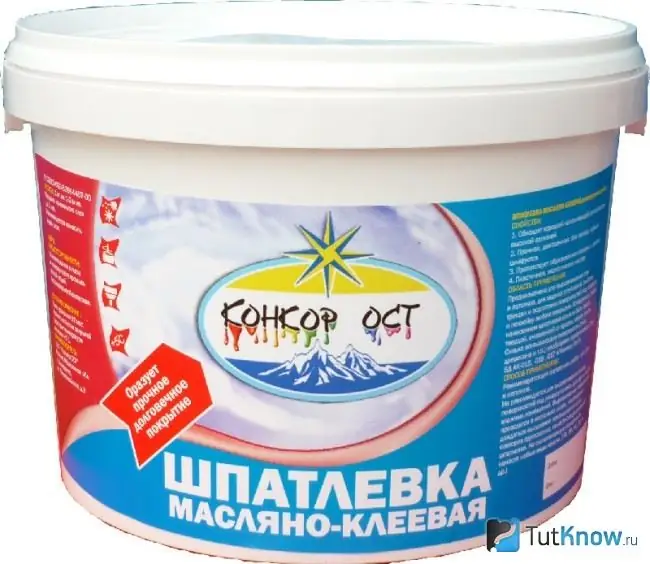
The basis for the manufacture of oil-adhesive solutions is linseed oil.
The main advantage of this type of materials for wall processing is low cost.
The limited demand for varnish-based putties is caused by the following disadvantages:
- Narrow application (only with materials based on drying oil).
- They are not recommended for use in residential premises due to the harmfulness of the components.
- The fragility of the coating.
Tips for choosing wall filler
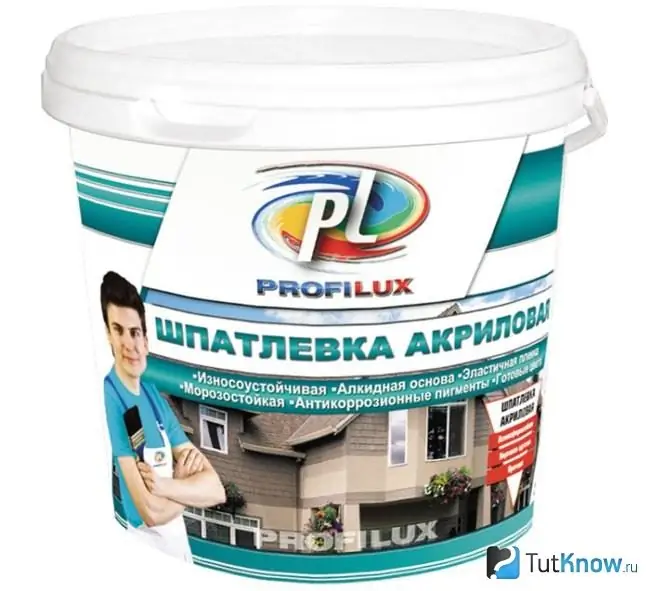
In each case, it is better to use the useful advice of specialists. This also applies to the choice of putty for the walls. So, how to choose a putty for walls - professional recommendations:
- The best result will be obtained when using materials from the same manufacturer, which are best compatible with each other, so the properties are combined and complemented.
- Always pay attention to the manufacturer's recommendations, which, taking into account the properties of all components included in the composition, describes the following: purpose (leveling the walls or smoothing the top layer of a flat surface); operating conditions (external or internal decoration, operating temperature, humidity level); conditions of use (microclimate during work); putty consumption; combination with other preparatory and finishing materials.
- To prepare walls for painting, it is better to use ready-made mixtures, because the quality of the finish layer will be higher.
- Dry mixes are more suitable as a base for wallpaper.
- When buying a ready-made putty, ask the seller to open the lid to evaluate the quality externally. In poor quality products, hard blotches can often be seen on the surface.
- For interior work, choose sand-free fillers.
- For thin light wallpaper or paint, the finishing putty should be as white as possible, so as not to affect the final color scheme of the wallpaper or cause the need to apply additional layers of paint.
- In cases where it is rather difficult to decide on the product, give preference to a universal mixture in order to reduce the risks of the wrong choice. Many experts choose acrylic filler, considering it the best filler for walls.
- The highest quality products are made by European manufacturers.
- Any putty may contain additional substances to improve the properties, so carefully read the composition and recommendations for the wall material that can be treated with each specific solution.
Watch a video about choosing a wall putty:

Buying a putty for walls is not a problem. It is important to make the right choice, taking into account the characteristics of the room, the characteristics of the decorative coating and your own preferences in the cost of materials.






